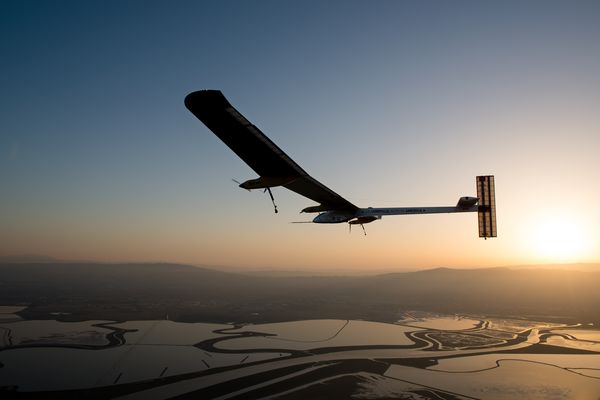Solar Impulse's U.S. Mission Ends This Weekend
Solar Impulse on one leg of its cross-country flight.
Shortly before 5:00 a.m. Saturday EDT, a solar-powered aircraft named Solar Impulse took off from a runway at Washington Dulles International Airport. The plane, piloted by André Borschberg, is heading to New York's John F. Kennedy International Airport, where it is expected to land around 2:00 a.m. EDT (11 p.m. PDT) on Sunday.
When Solar Impulse lands, it will be the first plane to travel across the United States during both the day and night without using any fuel. The aircraft—a Swiss-based project—started its journey on May 3, 2013, at Moffett Airfield near San Francisco, and has since made stops in Phoenix, Dallas, St. Louis, Cincinnati, and Washington, D.C.
Along the way, the plane and crew battled high temperatures in the Southwest, thunderstorms on the East Coast, and tornadoes on the Plains. The two-month-long cross-country tour prepares the way for their next, more ambitious journey-going around the entire world. That's slated to take place in 2015.
At the helm of Solar Impulse are two experienced Swiss pilots, Bertrand Piccard and André Borschberg, who trade flying legs of the mission. Both have extensive backgrounds in aviation. Borschberg is a trained fighter pilot and engineer, while Piccard, a physician, became the first to pilot a balloon around the world nonstop.
Designing the Plane
The two men designed the aircraft, which uses almost 12,000 silicon solar cells to power four electric motors, which in turn power the plane's propellers using special electricity-storing batteries.
The batteries are heavy, weighing in at roughly 880 pounds (400 kilograms). That's more than 25 percent of the plane's total weight, which is roughly equivalent to that of a passenger car.
"A normal person could not make an airplane like that," said Piccard in an interview last month at the Smithsonian's Steven F. Udvar-Hazy Center in Chantilly, Virginia.
"What we needed was two people with completely different experiences, with completely different backgrounds. André is an engineer and an entrepreneur. And I'm a medical doctor and explorer. Together, we cover the range of all of the [technical] possibilities that we needed to explore."
The two men take turns sitting in an extremely cramped cockpit in a plane that took ten years and $115 million to produce. Solar Impulse, which can climb to 28,000 feet (8,500 meters), can reach a maximum speed of 50 miles an hour (80 kilometers an hour) on its own. Strong tailwinds can boost the plane's speed to 100 miles an hour (160 kilometers an hour).
But speed hasn't been much of a factor during the pair's cross-country hops. The D.C. to New York leg, for example, will take 24 hours or more to complete—even though the distance between the two cities is only 228 miles (336 kilometers). A commercial, nonstop flight from D.C. to New York takes roughly an hour to complete.
An Experimental Plane
Because the plane is experimental, Federal Aviation Administration regulations stipulate that it must take off in the early morning hours, before other planes. Similarly, Solar Impulse must land after other planes have hit the tarmac. That means the plane's pilot will fly to JFK Airport and then circle for up to 24 hours.
"We're not in a hurry to get to the destination," said Piccard. "The question is: How to get to the destination so that we have a chance to enjoy the present moment?"
Both Piccard and Borschberg arm themselves with music in the cockpit to pass the time. Piccard prefers classic rock and opera; Borschberg's an Enya and country fan. They also revel in the joys of flying a unique plane.
"It's absolutely fascinating to fly an aircraft with no fuel," Borschberg said. "It makes no noise ... And being in the air makes you think about many, many things."
At the forefront of his mind: how to take what the Solar Impulse team has learned from the U.S. mission and apply it to a planned round-the-world journey to take place in 2015.
During that flight, the pilots will need to sit in the cramped cockpit for four to five days at a time as they make their way around the world. What they eat, when they sleep, and how they stay alert will all need to be worked out, said Piccard.
For now, the two men are considering what they've learned on this two-month journey and are focused on the end tonight.
"We're looking forward to seeing the lights of New York City," said Piccard. "And then, to see what happens next."
Melody Kramer
National Geographic
Published July 6, 2013












